Spotlight on Designer Nora David |
|
|
When I first heard of Nora David at the IHDA event (Independent Handbag Designer Awards), I was elated to know she was a Haitian Accessory Designer and I immediately tweeted about it. She was one of the finalists in the “Most Socially Responsible Handbag” category and that was a great achievement. Soon enough, we briefly commented and proudly congratulated her in our blog on June 15, 2012. We, at Haiti1Stop wanted to know more about this great designer, her style, her brand, her philosophy and her business acumen that no one has already unveiled. That prompted us to immediately get in touch with her for a great conversation and for a request of an interview. I must say that I was pleasantly honored to have spoken with her. It seemed that I’ve known her for a very long time based on personality and design background. My first call to her revealed a savvy woman who is witty, warm, real, eloquent, inquisitive, pleasant, natural, down to earth, friendly, decisive, and of course fashionable. She certainly captured my attention and I was ecstatic when she agreed to be featured onto Haiti1Stop “Conversations” segment. After arduous work and patience, we can finally deliver to our readers an insightful and inspirational interview with Nora David that truly captured her essence as no one has done before. She truly delivered in our interview as she talks about her childhood, her family life, her design concept, her journey as a businesswoman/factory owner and her upcoming nonprofit organization; and we are honored to have such great opportunity. Her profile and her journey to being the designer that she is today will unequivocally be a teaching tool and an eye opener to youngsters, upcoming designers, professionals and business women. You will get a sense of who she is along with her vision. Committed to her Haitian roots while giving back to her community, we are proud to feature Nora David in a different limelight. We welcome you to take on this journey of discovery as we present you the different facets of Nora David: the individual, the designer, the brand, the entrepreneur, the business woman and the philanthropist. We want you to enjoy reading each phase at your own pace and share it with your family, friends, colleagues and social media followers. We encourage all of you to visit her website at http://collectionsxaragua.com and support her efforts in keeping the locals employed in her community, and sending her employees’ kids to school. Thank you for such great interview Nora! Dahla |
Haiti1Stop: As women, we all are different creatures in the way we think, we create and deliver our passion to the world to make things happen. How do you define “YOU” as a woman? What are 5 adjectives that best describe you as a woman and as a designer?
Nora David: I think what defines me as a woman is the unconditional love I have for what I create. I would say that the best 5 adjectives that describe me as both woman and designer are: passionate, sensitive, patient, curious, simple.
Haiti1Stop: What is your motto in life?
Nora David: Don’t only go after what you need, go after what you want too. With only one life to live, you want to make the best out of it for yourself. There is nothing better than being proud of yourself (•‿•)
Haiti1Stop: How would you describe your childhood / upbringing in Haiti (give us a visionary picture in our minds)? Is there one thing that you are passionate about that you would like to share with us? Which subject did you enjoy the most while you were in school in Haiti?
Nora David: Today, I can say I had everything I needed when I was a child. The family ties are strong, went to one of the best schools, got a great education…When I look back, there is nothing that I would like to change…well maybe I would be more appreciative and stop complaining about everything hahahahaha
My favorite subjects were Mathematics, Physics and Chemistry.
Haiti1Stop: Do you have any siblings as talented as you are?
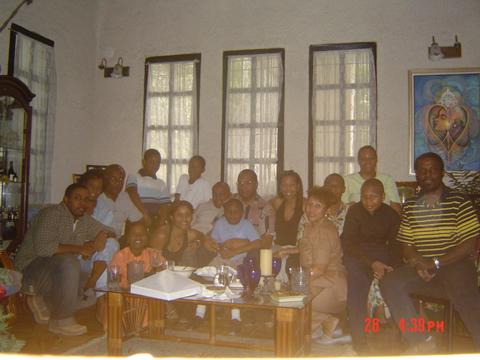 |
Nora David: Yes I believe we are all talented in our way. My younger sister enjoys drawing and she does it well; my younger brother is very naturally talented with graphic design and uses his talent to make some money while at university; and my older brother is my savior when it comes to change backgrounds, make websites and find any information related to Adobe software.
Haiti1Stop: You decided to settle in Haiti as a businesswoman, what is it about Haiti whether it is its arts, its culture, its scenic views, its lifestyle that inspires you the most as a child and as an adult? Can you say in one word what does Haiti represent to you?
Nora David: What inspire me about Haiti is the people; how they create with nothing. Yes Haiti has art, a beautiful culture; the views are out of this world, but everything lies in every single Haitian. To me, Haiti is Home.
Haiti1Stop: How early did your creativity surface? In which format did it surface whether in the form of drawing, painting, sewing or crafting? Was the passion innate in you to become an artist or designer?
Nora David: My creativity surfaced very early. It started with dressing up my dolls, then drawing and painting. Later my mother taught me how to sew. I remember in high school, I was designing outfits for my friends so they could look stunning and different to go to Heaven, a nightclub.
Haiti1Stop: Was attending design school, your first calling in life? If yes, did your parents inspire you into that path, especially having your mother as an accomplished businesswoman and designer and your father as an architect? If not, what was your first choice of study?
Nora David: Believe it or not, it wasn’t my first calling in life. Because I was good in Mathematics, I first thought of being an engineer. Then I was attracted to management. It’s only during my last year of school, that I decided the best thing for me would be to mix fashion and management! Best decision!
Haiti1Stop: At what age did you create your first artistic project? Do you still have it among your creative treasures? If yes, would you share with us what it was and submit a picture to us?
Nora David: My first artistic project was an abstract painting I made. I was 11 years old. I’d love to share it with you but unfortunately this painting is now in storage.
Haiti1Stop: Which factors influenced you to enroll in the Fashion Design School of Montreal located in Canada? And, why Canada and not the U.S. or France? How long have you lived in Haiti prior settling in Canada to pursue your studies?
Nora David: The reason why I chose Montreal was because it is one of the top fashion capitals. And it’s only 3 hours away from Haiti. The Fashion Design School of Montreal was also the only school offering exactly the program I was looking for, Fashion Management.
I’ve lived in Haiti for 19 years before going to Montreal…
Haiti1Stop: What inspired you in becoming a handbag designer and not a clothing designer first? Have you always had an affinity for handbags? How would you describe the similarities and differences in delivering a clothing line versus a handbag collection?
Nora David: It was a business decision. The investment was less to start with handbags than to do so with a clothing line. I do have an affinity for handbags, I can’t even count how many handbags I have! My creations are not limited to handbags though; I design clothes, jewelry and shoes too. I plan to have a full line.
Delivering a line, whether clothing or jewelry, has its challenge. I cannot create just for the fun of creating. I have to follow the “fashion rules”, the trends, the shapes, etc. The difference between clothing and handbag is that you get to play more with the handbag as you can add so many different accessories to it and mix the fabrics as you wish.
Haiti1Stop: What is the most valuable lesson you retained from your school age of design? How tedious was the program at the school? Did any professor influence you in a memorable way that captivated your love for design? Which elements of the handbag classes did you enjoy the most and / or help you shape your business?
Nora David: The most valuable lesson is the customer will or will not like your design. So you have to distance yourself from your creations and accept critics for the best.
I have to admit that if you are not made for this world, you won’t make it past the first year of school. It never never never ends, it’s never good enough. Inspiration is the key because you have to come up with something different in this saturated market..
The construction of garment and handbag is the key to your business. It’s how you put it together that makes a difference in visual and quality, thus different from the competition.
Haiti1Stop: Can you tell us if you have a designer in mind that you’ve always admired in the fashion industry? What is it about the designer or artist that is appealing to you?
Nora David: Yes, Gabrielle Coco Chanel. She was determined to rise from her humble origins. She was creative, took risks, and changed the way women dressed. Not to mention the little black dress and the bag that finally freed the women’s hands, the 2.55 (•‿•)
Haiti1Stop: Does Nora David have a specific fashion style that she identifies the most?
Nora David: Yes, I do and this makes me remember that a friend of mine had told me one day that I am classically chic. I am a woman who loves her life and life in general. I am confident and assertive, and friends and family know that if they need help solving a problem, I am here for them. Therefore looking pulled-together at all times is a priority for me. That’s why I rely on classic, simple items that don’t require a lot of thought and have timeless style. To that classic look, I will add my touch of sophistication by wearing prints on prints, or a plus size outfit with a belt to give it that extra loose look, but take each piece I am wearing and you will see it’s a simple item.
Haiti1Stop: What does the word “DESIGN” mean to you? Do you see yourself as a trendsetter? Do you follow any international trends?
Nora David: Design is Create, let your inspiration take over and create. Yes, I do follow international trends for colors and shapes. But for trimmings and details, I design my own.
Haiti1Stop: What is your Designer tip of the day?
Nora David: Mismatch matches too. Try some prints on prints (•‿•)
Haiti1Stop: In designing a handbag, what is your most precious possession that you have to have in every design process (a tool, a notepad, a ritual etc…)? Is there such thing as a design mistake? Do you have a story to share with us about it?
Nora David: A notepad, a black pencil, color pencils…Yes, a design mistake is very common. When you design, sometimes you tend to forget about the technical, practical and doable. Hahaha yes, I do have a story. I designed a purse that everybody loved! It was so beautiful that I decided to make it the signature purse. I had forgotten one little thing: I designed the handles to be on the straw. Big mistake as the straw is not strong enough to hold the weight…
Haiti1Stop: Which elements about a handbag do you like the most? How many handbags do you own?
Nora David: I would say inside pockets and cellphone pockets. Well, I don’t know for sure but I believe around 100…
Haiti1Stop: What inspires you as a designer every day to think, breathe and create handbags?
Nora David: Periods of time, paintings…
Haiti1Stop: Creating a handbag demands a creative process from the inspiration, sketch, theme, color, shape and design, materials to be used leading to a story board. Can you share with us the journey of this process so we can envision your design space into creating a handbag?
Nora David: First, I would choose a theme. Following the color trends and staying within my theme, I would go fabric shopping. Then, I would put some Vangelis type of music, sit with my fabrics and start creating…
Haiti1Stop: As a creative artist, I hold on to the first projects I’ve ever done to set the tone for the next project. Do you do the same in keeping your first design projects or do you discard them especially if they are not of good quality? And, do you still have the 1st handbag you ever designed? If yes, would you share a picture or description of it with your fans and Haiti1Stop?
Nora David: I keep all my projects, good or bad. And yes, I still have the very first handbag I designed…
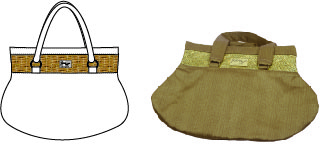 |
Haiti1Stop: Can you describe to your fans the different styles of handbags that exist? What is your intake in selecting the perfect handbag? Should a person pay attention to their body structure to select a handbag?
Nora David: There are 20 styles of handbags. The most popular ones are the bucket which is a shoulder bag in a shape of a bucket, the tote which is a carry-all square bag, the clutch, the messenger bag which is a roomy bag with adjustable strap, the satchel which has a wide and flat bottom and short handles, the hobo which is a shoulder bag that dips in the center, the wallet, the backpack….
Yes, a person should pay attention to their body structure. Just like you try on clothes, you have to try on a purse. It has to fit and it has to be comfortable. Not every bag fits every body type either.
Haiti1Stop: Do you think a designer should be a great sketcher and / or patternmaker in order to launch their collection? Which qualities do you think a person should possess in starting a handbag collection?
Nora David: I do think you need to be a great sketcher, because the sketch is the beginning of everything. If the sketch is wrong, the chances of having the handbag right are slim. It is definitely a plus if you can make your own pattern. Sometimes the patternmaker might not see your vision and only you can make it.
To start a handbag collection, you need to know handbag construction, what components should go into the making of the handbag. It is a plus if you can make the first sample yourself, to find out there might be a problem or not.
Haiti1Stop: In the fashion / accessory world, who do you think might be your biggest competition or an inspiration to you and to the vision of your brand whether it is contemporary, futuristic?
Nora David: My biggest competition is the already well known brands. And they are also my inspiration as I would like to see my brand as popular.
Haiti1Stop: Would you share with us, which companies did you work as an independent designer after graduating from the Fashion School of Montreal? What are the most valuable lessons you’ve learned from working in those companies? Would you recommend an aspiring designer to work for a company or intern prior launching their own line?
Nora David: I would definitely recommend an aspiring designer to work for a company prior to launching their own line. First reason is you get to make contact with key people in the industry, whether it is supplier or potential client, and you get to learn from the inside how this industry really works.
Haiti1Stop: We think that all Haitian designers should support each other in such competitive industry and may the best win. So, how have you seen support from your fellow artists? If not, what would you wish for?
Nora David: I have to say that my generation is very supportive. We encourage each other a lot. I get support from other designers and they get support from me. I wish it was like that at all level…
Haiti1Stop: Some people in the fashion industry identify Haitian people as being crafters and not designers. And, those few Haitian designers that are doing well in their craft are not known to the public. How would you differentiate a crafter versus a designer? And, how can we break that stigma of being not as qualified of a designer for those who have doubts about us?
Nora David: Yes, they tend to see designers as crafters. But there is a difference. The designers create and the crafters execute. In my case I create the handbags but I don’t weave the straw, thus I am the designer. The people weaving the straw are the crafters.
That stigma can only be broken by us designers. We have to stop accepting people (mostly the foreigners) referring to us as crafters. We have to make sure they refer to us by what we are. If the media says “crafters” we have to contact them and have them correct it to “designers”. If a famous foreign designer introduces us as “crafters” we have to correct him/her and have him/her introduce us as “designers”…
Nora David’s Collections Xaragua. The Brand
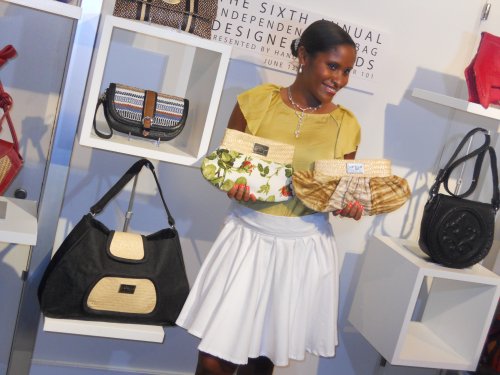 |
Haiti1Stop: We congratulate you again for bringing Collections Xaragua to our door steps. We are curious to know, how did you hear about the IHDA (Independent Handbag Designer Awards)? Are you planning to re-enter the competition any time soon?
Nora David: I was doing some research online about handbags and found their website. As I was browsing, I saw the contest and decided to participate. Yes, I am planning to enter the competition next year.
Haiti1Stop: What is the best way for people to know about your next event show?
Nora David: It would be through the social media, facebook, twitter @CXaragua and our website at www.collectionsxaragua.com.
Haiti1Stop: You submitted the beautiful “Adabelle” style handbag to the IHDA? We want to know how did you select which handbag to submit to the competition? When did the “Adabelle” handbag make its debut?
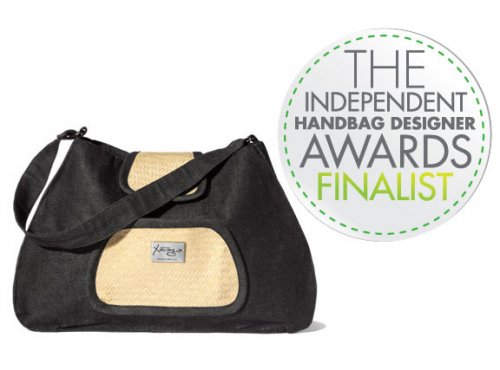
Nora David: I selected Adabelle for the competition simply because I love this bag: very versatile for an everyday bag, big and strong enough to hold a laptop, cellphone front pocket for easy access, the flat bottom makes it easy to reach inside…
Adabelle made its debut for the Spring-Summer 2012 collection.
Haiti1Stop: When I attended the IHDA event, what struck me was the name of your collection: “Xaragua”. I find it to be strong, fitting, historical and meaningful. Congrats on the brand name!
Now, was the name Xaragua, your first choice of name for your collection? Or did you have a discussion about it prior of selecting such name? Would you share with us the story behind the name “Xaragua” for those who do not know of it?
 |
Nora David: Yes, it was my first choice. I wanted a name that screams “Haiti” and also that I could relate too. Xaragua was the most popular chiefdom with a Woman as head of state. I want to make Collections Xaragua the most popular Haitian brand owned by a woman.
The origin of the brand name, Collections Xaragua, obviously comes from Haitian history. It is my way to pick every one’s curiosity so they can learn about Haiti, when it was called Hispaniola. Before the slaves were brought to the country, Haiti was a peaceful and beautiful country, inhabited by the natives (called Indians by Christopher Columbus). Xaragua was one of 5 and the most popular and strongest of the chiefdoms of Hispaniola, it was a chiefdom in which 2 of the most influential caciques were a brother and sister, Behecchio and Anacaona. Xaragua was in the southwest peninsula. They grew lots of cotton here and also in the cul de sac, north of where Port-au-Prince lies today. It was full of peaceful Tainos that were very peaceful but were killed due to trickery and hate.
Haiti1Stop: The brand name is very important to set a designer apart from many other brands. What is the best advice would you give an aspiring designer / artist on how to define their brand?
Nora David: You always gotta have a story behind your brand name. In my opinion this is what will keep you grounded and focus. The same way your story tells who you are as a person, the story of your brand will make your brand be what it is.
Haiti1Stop: For those people who do not know, when exactly did you officially launch your line? Why did you choose such date?
Nora David: I launched it on April 30th 2011 at the very first edition of Runway Haiti. It is not the date that I chose, but the event. I chose this event because Runway Haiti was a platform to gather all Haitian designers on a runway to promote our designs locally and internationally.
Haiti1Stop: How would describe the Xaragua collection style? Who is the customer that would wear your handbag? Do you listen to their feedback? And, where do most of your customers come from?
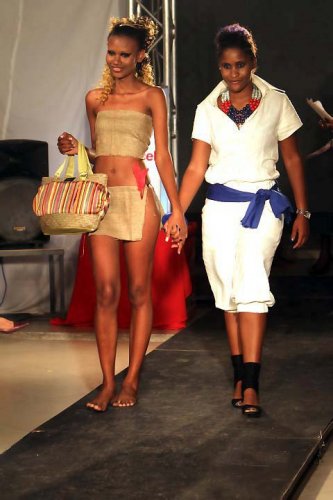 |
Nora David: Collections Xaragua is a line of handbags consisting of unique shapes that are trendy and chic to go with every woman. The brand is a modern twist on the classic handbag with a combination of bright colors and palm straw; the signature of Collections Xaragua. The customers that will wear my handbag is a professional woman who chooses carefully her outfits and likes to make a statement by what she wears.
Yes, I do listen to their feedback, as this is what will help me satisfy them better and better and understand their needs. Most of my customers come from Haiti. Now that I just entered the Floridian market, I am starting to have a wider range of customers.
Haiti1Stop: You design different styles of handbags, each one with a special name. What inspires you from selecting those names for your handbags (like Selma, Yedda, Heloise, Rexana, Blanda, etc.) Does the name underline the style or the personality behind the handbag? And, which style do you like the best and why?
Nora David: Every name has a meaning that underlines the personality of the handbag. For example Selma means safe. The construction of Selma makes it easy for the holder to open the handbag, but difficult for someone else. Plus the bag is reinforced to support an up to 17” laptop. It’s the safest one in its category.
It’s hard for me to tell which one I like the best hahahaha. But, the Edina, which is the crossbody bag is one of my favorites. It carries everything I need, has an easy access front pocket and my hands are free! I carry it all the time!
Haiti1Stop: What is the retail price of your handbag? Do you also sell wholesale in case there might be people interested in carrying your line in their stores? What is the method of payment that you accept?
Nora David: My handbags vary between US$35 and US$135. Yes, I do sell wholesale and they can contact me via my website or by email at info@collectionsxaragua.com.
I accept paypal, direct deposit, cash.
Haiti1Stop: Are there any stores in Haiti that carry your collection? If yes, which ones are they? And, do you intend to open a store in Montreal in the future?
Nora David: For now there are no stores in Haiti carrying my collection but It will happen very soon, before the end of the year (•‿•)
For now, I have no plans to open a store. I’d love to see my bags in different existing stores.
Haiti1Stop: Currently, your website does not allow online purchasing, how can a person from overseas purchase your handbag? Are you able to deliver your handbags to overseas? If yes, to which countries?
Nora David: Yes, the person can contact me via the website and mention which handbag she would like to purchase and we go on with the transaction via paypal. Yes, we can ship anywhere, shipping paid by the customer.
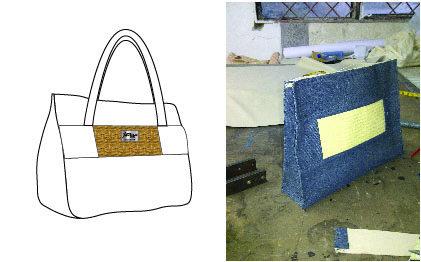 |
Haiti1Stop: Each designer has something that elevates their heart rate and drives them to finish their product. Which one is it for you: the sketching (using a pen or a computer), the selection of materials or the finished product?
Nora David: It’s the finished product. Mostly when from the start I can see it will look exactly how I had it in mind…
Haiti1Stop: What is the time frame would you say it takes to achieve your finished product from the concept, inspiration to prototype?
Nora David: I cannot really tell. Every creation is different. But I can say it takes from 3hours to weeks…
Haiti1Stop: You use eco-friendly materials such as straw, siam and fabric for your handbag collection. What made you want to proceed into the eco, sustainable design path? In which regions of Haiti do you outsource those materials? Is the woven straw easy to obtain in huge quantity or do you have an assigned supplier? Do you see yourself expanding your current sustainable materials to other types of materials?
Nora David: I didn’t necessarily choose to go with eco-friendly materials. My choices were all made around “Haiti”. I chose the straw for the lining of the purses to give it a historical link with Haiti. We used to produce the straw in Haiti, and even though the industry has died, straw remains a “cultural” fabric.
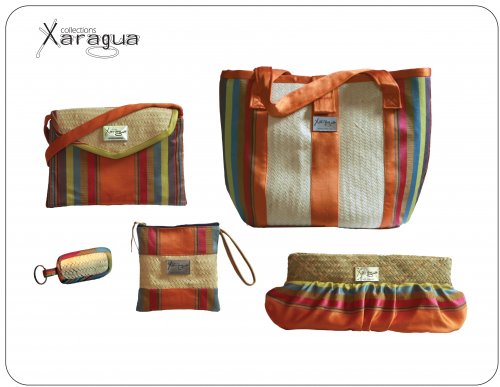 |
I chose the palm straw because I wanted my handbags to have a Haitian authenticity. This is why I incorporated the straw into my designs and made it the signature of the brand.
I do have assigned suppliers for the straw. I place my orders according to my production and they deliver it. But no rush order can be placed; I have to plan very well to not run out of woven straw.
Yes I see myself expanding to other types of materials, but will always keep the Haitian authenticity.
Haiti1Stop: How would you best describe the siam and straw materials for those people who do not know what they are?
Nora David: The siam is lossely woven cotton fabric and the straw is dried palm leaves.
Haiti1Stop: What is thrilling about owning your own business? Walk us through the process from the time you conceptualized the idea to its reality from the legal to business points of view?
Nora David: Owning your own business requires more discipline. What is fun about it is that you get to decide when or where you are working. But sometimes not having a boss, makes it harder to concentrate and do the work, mostly when it comes to not so urgent things. It is also more stressful to own your own business as the paychecks are not guaranteed every two weeks and most of the time you have to manage the income on a longer period of time. But at the end of the day you get to do what you enjoy and that feeling you get when you see your employees and customers happy is indescribable.
I conceptualized the idea in 2 hours. I created my first line in one hour and the business was up the next day. Yes, as simple as that (•‿•)
Haiti1Stop: How long have you lived in Canada before settling again in Haiti as a businesswoman? When did you know it was time to make such a bold move?
Nora David: I’ve lived 7 years in Montreal. I just knew. I felt empty not doing something helping my own country.
Haiti1Stop: The 2010 Haiti Earthquake was a catastrophic event where many of us felt disarrayed and the country needing economical, physical, emotional and psychological help. So, did you have any reservations starting a business in Haiti right after the 2010 earthquake with the uncertainly that lies ahead with the country? And, what are the tasks that you fulfilled to determine where you want to locate your business in Haiti?
Nora David: Not at all. The earthquake was what actually convinced me to do so. A year after the earthquake, I felt that nothing was being done. That’s when I decided instead of just having an opinion, to act and do something myself. Creating jobs to make people be able to sustain their family is my main goal.
I located my business in Port-au-Prince because it was easier. I grew up and lived in Petion-Ville. Even though I’d wish to have the business outside of Port-au-Prince, I had to make a decision based on costs. Maybe when things go better, I will relocate…
Haiti1Stop: You came from an accomplished, talented, artistic entourage. Do you think your family entourage gave you the confidence and financial tools needed to launch your own company, especially having your mother Maëlle F. David as a role model?
Nora David: Definitely yes. My family and mostly my mother gave me all the support and tools I needed.
 Haiti1Stop: Did you encounter any roadblock/challenges in starting your collection and opening your company in Haiti? If yes, describe them. And, what will be your best advice to aspiring entrepreneurs?
Haiti1Stop: Did you encounter any roadblock/challenges in starting your collection and opening your company in Haiti? If yes, describe them. And, what will be your best advice to aspiring entrepreneurs?
Nora David: It’s no secret that in Haiti, things might be difficult. But nothing is impossible. Everyday there are challenges but you have to work with them and find the way around it. My best advice to aspiring entrepreneurs is to start with solid roots. If your feet are not well rooted to the ground, you will fail easily. Nothing is impossible; if you want it make it happen. Patience is the key; don’t go in any business thinking you will succeed first shot! Stay positive and listen to your customers, friends and family and make the best of all the advices you get.
Haiti1Stop: Have you heard of the Digicel Entrepreneur of the Year contest in Haiti? Would you ever enter such competition in the future?
Nora David: Yes I have. I am planning to enter this competition next year as one of the requirements is the company should be running for at least 2 years.
Haiti1Stop: There are talented Haitian artists that design for passion and not for monetary value. But to cover the overhead costs and sustain longevity, it is critical to be aware of the financial aspect including costs of raw materials and labor time for the artist, equipment maintenance and much more. What are your insights in teaching your fans and aspiring entrepreneurs the dos and don’ts in creating their projects while maintaining a sufficient living for themselves?
Nora David: You should always have your customer in mind. You have to know them, how much money they make, how much they spend. You should never fix a random price thinking it’s enough to cover cost and make profit. You should always calculate your cost, your margin of profit and your price.
Haiti1Stop: In NYC, we have the fashion garment industry and most runway shows are held at the heart of Manhattan. So, where would you want to see the renaissance of fashion or the capital of fashion in Haiti? How do you see the fashion industry evolving in Haiti in terms of manufacturing and materials sourcing?
Nora David: I’d love to see the capital of fashion in Haiti to be Jacmel. Only two hours away from Port-au-Prince and you get to enjoy the beach and the mountains. It would be perfect if Jacmel had their own international airport.
The fashion industry is emerging. Manufacturing small lot still remains a challenge though. Materials sourcing is very easy, the challenge is to stay within the international trends.
Haiti1Stop: I believe we are capable of producing handbags and footwear but we need skilled technicians in the field, great equipment, schooling and continuing education in the field with tons of training, great craftsmanship and discipline in quality and delivery. What are your views about this issue? Can you see Haiti among the many other manufacturers like China, Mexico and other countries for handbag manufacturing?
Nora David: I agree with you, we do need discipline in quality and delivery. I definitely can see Haiti for handbag manufacturing, but not in a near future. There is a lack in training and in skilled technician, not to mention the equipment. But I believe with all these foreign companies producing in Haiti, we will have more skilled technicians and better equipment.
Haiti1Stop: Craftsmanship is a key factor in handbag design. We’d like to know how do you keep up with all standards a) to increase demand for your brand and b) to participate in international shows?
Nora David: I do a lot of training with my employees and trying to change that mentality of accepting imperfections. I keep my quantities low to assure great quality. In my book quality comes before quantity. I communicate with my customers so they can understand the craftsmanship behind each handbag.
When I participate in international shows, I play by the same rule. Quality is more important than quantity. Therefore it is important to place the orders within the timeframe.
Haiti1Stop: How do you set yourself aside from other brands? What is your intake about imitation?
Nora David: Simply by having my own brand, my own personality, my own story. It is important to offer a product your customer can relate too, thus the reason why I want to be “friend” with my customer.
The only good side of imitation is that if you are being copied, it’s because you have a great product. But, I totally disagree with imitation as I see it as a form of disrespect towards the work of a person. You can used someone’s work as an inspiration, but imitating is a no-no.
Collections Xaragua. The Business & Kind-Hearted Woman.
Haiti1Stop: Is your company also called Collections Xaragua, same as your brand name? Where is your company located in Haiti? How would you describe your business model in Haiti? Would you mind sharing with us your mailing address for your company?
Nora David: Yes, same as my brand name. The company is located in Delmas 29.
Collections Xaragua is a social enterprise. We give back to the community by sending the kids of our employees to school, by volunteering in social events such as food drive, back to school…
The mailing address is #4A Rue G. Sylvain, Delmas 29, Port-au-Prince Haiti
Haiti1Stop: How long after graduating the Fashion School of Montreal, did you start your company? What were the steps you tackle to open your manufacturing handbag company in Haiti? How long did it take you?
Nora David: Six months after graduating in 2006, I acquired a winter accessory company that I will sell at a later time. I then worked for 2 years as an independent designer and in 2010 Collections Xaragua was born. It took me 5 months to have the company running as it is now. Little by little I was acquiring what I needed to have a complete production line. I started with one sewing machine and buying material for a dozen handbags at a time and now I have much more sewing machines and an inventory of material and trimmings.
Haiti1Stop: How many employees do you have? Among them, how many are women?
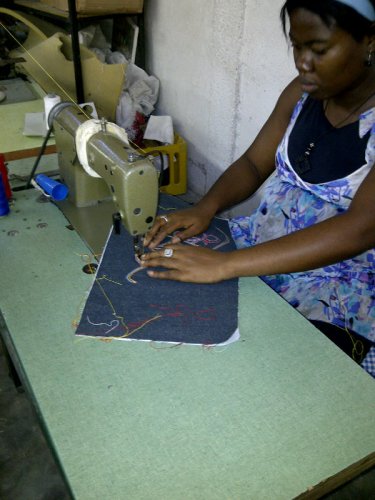
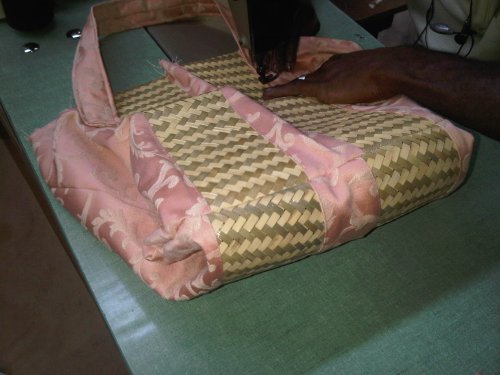
Nora David: I have 4 full-time employees and 7 part-time. They are all women except for one.
Haiti1Stop: Was it a challenge for you to recruit employees with handbag construction training? If yes, did you have to educate and train them?
Nora David: It is a real challenge. I constantly have to educate and train them.
Haiti1Stop: How do you envision yourself, Nora David the brand, the company in 5 years down the road?
Nora David: 5 years from now, I see Nora David the brand as a well known designer. I see my handbags in many stores in America and the Caribbean. I see more jobs created and more kids staying in school.
Haiti1Stop: Describe to us your typical day at your company overseeing the designs and running your company in Haiti?
Nora David: It is hard to describe as I don’t really have a typical day. I manage the company by myself; my tasks are a million in a day. There are days that I spend replying to emails, others that I design, or supervise the production. There are days that I spend only testing materials. Other days are reserved for research on trends, materials, styles…One thing I can guarantee is there are no boring days. hahahaha…
Haiti1Stop: How do you recruit the models to showcase your collection? Is your priority to select solely Haitian models?
Nora David: For now, my priority is to encourage Haitian models. I recruit them via model agencies or friends.
Haiti1Stop: Would you be open to manufacture handbags in Haiti for other designers who might be interested in having their products made in Haiti?
Nora David: Definitely yes.
Haiti1Stop: Have you ever thought of having a custom design division at your company for those clients who may want something personal and different for them? In the end, they would be the ones selecting their specific style & color.
Nora David: Yes, custom designs are welcome (•‿•)
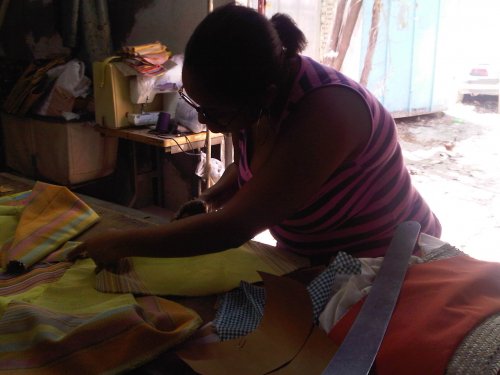 |
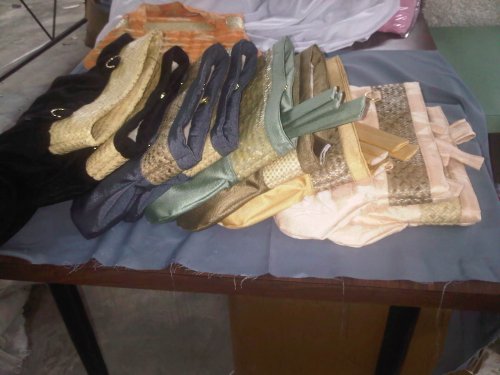 |
Haiti1Stop: There are many Haitian designers who are thinking just like you, opening their own factory / company in Haiti or employing people from Haiti to deliver their products. Explain to us if this was a difficult process to achieve? And, what would you say is the first step to take to establish success and making this dream a reality?
Nora David: Yes it is a very difficult task to achieve because it is really hard to find skilled technician and sometimes you have to wait months to find the right equipment. The first step is to gather everything you need to make your product. Do not start your marketing if you don’t have all the tools to deliver. And again the key is to be patient.
Haiti1Stop: You seem tuned with exposing your brand in local and international events such as Runway Haiti, Women In Production, the Hawaii silent auction and the IHDA. Is it important to you to promote your brand in many outlets as you can? How has been the demand of your brand after participating in those events? How often do you travel in the U.S. or overseas to promote your brand? And, is it part of your journey to being a constant traveler?
Nora David: It is very important for me to promote my brand. I’ve gotten positive feedback from all the events I participated in and it got the brand to be known. I travel very often to Miami, which I consider now my second home. I promote a lot in Florida for its proximity with Haiti. I’d love to travel more to promote the brand everywhere in the Caribbean, South America and even Europe, but I believe it will be for a later time hahahaha…
Haiti1Stop: What would say is your best experience participating in those event shows? What have you learned from them? Are you planning to make this a tradition every year and do you have any other events you want to be part of? And, what is your advice for those designers who want to participate in the runway shows or trade shows?
Nora David: The best experience is to listen to the customers. You learn about their needs, their taste and their opinions. This information is crucial to any design you want to make in the future. Yes I will make it a tradition every year, and I am also open to other events. Everything now is a matter of cost. If I can make it, I’ll be happy to do so and offer my products to more potential clients.
Before you decide to participate either in a Runway Show or Trade Show, remember to calculate your cost. It’s rule #1 of business. Do not participate just to participate; you also want to be able to sell. For example, if you are doing a Runway, you don’t want to be out of stock for what you showcased. If a client wants to buy, this is the best time to sell. If the Runway is solely for marketing purposes, make sure you have the best pictures so you can use them to sell your products.
Haiti1Stop: Do you plan to start a clothing line? If yes, would you ever collaborate with your mother on a ready-to-wear collection or start a new project venture with her or other designers?
Nora David: Yes I do plan to have a clothing line. I already collaborate with my mother for her designs. We both have very different style but a collaboration is always fun. I’d be open to working with other designer for a ready-to-wear collection…
Haiti1Stop: You use local materials for your handbag construction where other people are known to use materials from China and elsewhere for their handbags made in Haiti. We are curious to know your insights about this issue.
Nora David: Every entrepreneur makes the choice that is best for him/her. I choose local materials because I am a social entrepreneur and I also want to encourage Haitian economy. By buying my material locally, I encourage the Haitian businesses. It’s just a choice I made because I don’t only want to see myself succeed, I’d love to see Haiti succeed.
Haiti1Stop: We are aware that your company helps to educate the children of your employees. You are certainly giving back and that makes you a philanthropic woman. Tell us more about this idea of yours and what triggered you to take the nonprofit route?
Nora David: I believe most of Haiti’s problems are due to lack of education. It is too bad that education is not given to everyone. Therefore I took matter in my own hands and decided to give education to as many kids as I can. Hopefully more young people like me would choose the same path and in the future, we’d have an educated country. I am who I am today because of the education I had. It would be selfish from me to not give this chance to another human being.
Haiti1Stop: When do you plan to officially open your nonprofit organization? Do you already have a name for it? Which area of Haiti would it serve? What educational activities / projects would you have? Haiti1Stop would be delighted to cover this new endeavor of Nora David from its starting point to its final phase. Do keep us posted!
Nora David: I am planning to officially open the nonprofit organization in March 2013 and organize our first big event for back to school 2013. Yes I do have a name for it, but I will share only when I register it. hahahaha…
I would start with the South and South West of Haiti to eventually serve the whole country. Yes, it is a big project and it is my dream! I will definitely keep you posted as I am sure it will be a nice journey together!







